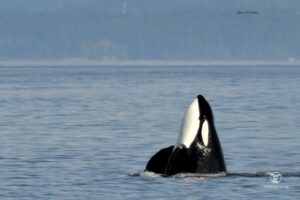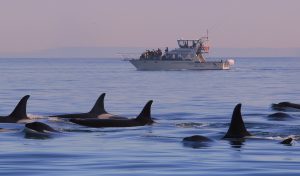Where is the place in the world to see whales?
There are many, many species of whales spread across all the oceans of the world. Each species will have a preferred distribution and movement within its usual range. The controlling factor is access to food. Whales move primarily to find prey in sufficient quantities for their survival. When your the size of a whale then you need lots of food.

The prey species may vary from the smallest plankton to giant squid dependent upon the preference and feeding habits of the whale. Regardless of the size of the prey, it too is always on the move. Either drifting with tides and currents, rising and falling as day turns to night or predating on smaller prey species.
The one thing common to all of the whales is movement. Whales do not stay in one location. Individuals continuously travel. They are usually within a broadly defined area. But here’s the catch if you want to see them. That area will be over thousands of square miles. The Oceans are very large places!
However there will be areas within this vast space that will be more heavily frequented. These will tend to be areas that are rich with prey species.
This constant movement is not just through space but there is also continued change across time. There will be cyclic peaks and troughs in the density of life found within this large oceanic range throughout the calendar year. As the seasons change and this preferred area receives more light and energy from the sun. Then the phytoplankton can bloom forming the base of many food webs and allowing larger and more complex life to flourish.
If viewed over a larger timescale of decades or more we can see the movement of these preferred areas in response to changing trends related to climate, oceanic temperature, salinity or pollutants and their affect on the food webs which sustain these voracious feeders.
The industrialization and resultant impacts on climate and pollutants can be seen to be an enabling factor that speeds changes faster than the life within these intricate webs can respond and adapt to the incoming changes. Such that a successful species pre-industrialization would have adjusted range and behavior at a matching speed to adapt to changes. Post industrialization this becomes a much more demanding task and so we are losing species at a greater rate than before.
So with all of that in mind, maybe we can start to answer the question posed above ‘Where and when is the best time and place to see whales?
Best whale species for viewing
Which species are the best to be viewed? well, two species of whale stand out from the rest.

The first are Humpback whales, these are large animals and can be over 18m in length weighing over 30 tonnes. So very impressive animals. However they can also be found close to land in shallower depths that the deep ocean which means that they surface much more frequently than other more deeper diving large whales. This makes humpbacks easier to view and unfortunately for them it also made them easier for whalers to hunt and so these populations were heavily reduced due to commercial whaling. Thankfully with legal protections in place and the majority of country’s abiding by them humpback populations have rebounded successfully.

Second, but first for many people are Orca’s. Simply due to their iconic looks and the thrill of viewing the oceans top predator, for many there is nothing better to see than a pod of Orca.
They are highly social, highly intelligent specialist predators that can be found in every ocean. They also continually travel 50 – 100km per day. This means that to view them with a high degree of success takes a special set of circumstances.
Where is the best place to view whales
The ‘where’ part of the question has two parts. 1. Where can I find a reliable number of transiting whales such that if I was to be in one spot its likely that there will be whales within sight? 2. Where can I find such a place that is accessible so that I can reach this place without great difficulty or cost?
The Antarctic
The Antarctic waters would be an excellent answer to the first part of the question. Here are incredibly rich waters including large numbers of krill support large populations of Antarctic based whales. However for most of us these waters are not a place we could easily or affordably reach.
Alaskan Waters, USA
If we move from the cold rich waters of Antarctica to the cold rich waters of the Arctic again we can find large populations of whales. The humpback whales that feed and move through the summer Alaskan waters can exhibit a feeding behavior known as bubble net feeding. This happens for a small amount of time when the conditions are just perfect so that a group of whales will hunt collaboratively to drive prey into a tightly packed ball at the surface. the whales then lunge upward through the prey rich waters to break the surface huge mouths gaping to feed. The result is an amazing spectacle. But one that requires luck and patience to catch as this bubble net feeding technique may be seen only a few days or weeks each year.
Hawaii, USA
Those same humpback whales that have there summer feeding range along the coastline of Alaska and British Columbia migrate during the winter months of the northern hemisphere to breeding and birthing grounds in the warmer tropics. Hawaii is one such favorite area. Here the whales find safe warm waters where calf’s can be born with the time to put on precious blubber before the return to the cold rich waters further north.
The best time to see whales here is usually January or February. Those whales here to breed may exhibit amazing behaviors including fully breaching as they leap out of the water, and the amazing acoustical display that is the song of the humpback whale
Victoria, Southern Vancouver Island, British Columbia, Canada
 The place with the highest year round whale sightings success percentage at over 95% success rate is the waters surrounding the city of Victoria on the southern end of Vancouver Island, Canada. In terms of consistency a the waters around Victoria, BC are very hard to beat. The best time to be here is spring through till late fall. The best time to see multiple species in the same area has over recent years been late September to late October.
The place with the highest year round whale sightings success percentage at over 95% success rate is the waters surrounding the city of Victoria on the southern end of Vancouver Island, Canada. In terms of consistency a the waters around Victoria, BC are very hard to beat. The best time to be here is spring through till late fall. The best time to see multiple species in the same area has over recent years been late September to late October.
The waters around Southern Vancouver island are known as the Salish Sea, in respect to the Coast Salish peoples. The waters are a collection of protected straits and 416 islands. All of this is surrounded by snow capped mountain ranges.
The waters from the snowmelt cascade into the Salish sea bringing a huge amount of nutrients. This nutrient load combined with that brought up from the deep waters off the continental shelf through upwelling and tidal action provide a sheltered nutrient rich environment historically rich in herring and salmon. The rocky islands provide the perfect place for seals and sea lions.

This area originally came to prominence as a great place to view whales due to the prevalence of large groups of Orca, known as the Southern Resident Killer Whales. They would hunt chinook salmon in groups of 20, 30, and often more through the spring, summer and fall months. In more recent times this population has been supplemented with increasing sightings of mammal eating killer whales and an explosion in the numbers of humpback whales. These populations along with Gray and Minke whales has meant that sightings continue year round.

Humpbacks now can be seen with regularity from the months of February through December with large groups and the population peaking late fall. As the numbers have risen the observed behavior has become more complex and fascinating to watch. With breaches and lunge feeding behavior becoming more common.
The record numbers of seals living along the intricate rocky and wooded coastline has provided an improving environment for the mammal eating killer whales. These are often found hunting in pods for harbor seals along the coastline or for porpoise deeper into the straits.
Any and all of these options are amazing places to view whales. If you can find your way to any of these places you must find a way to get out onto be water and see these wild whales with your own eyes. We would love to welcome you on board with the crew here at Springtide Whale Watching & Eco Tours.
Written by Captain Ian
[post_grid id=”10982″]
